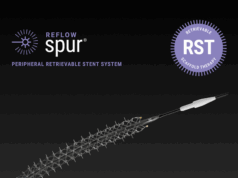 Researchers suggest that in patients with chronic limb-threatening ischaemia (CLTI), two-dimensional (2D) perfusion angiography is a “reliable tool” when used according to standardised methods. Jetty Ipema (St Antonius Hospital, Nieuwegein, The Netherlands) and colleagues write in the European Journal of Vascular and Endovascular Surgery (EJVES) that theirs is the first study to test the reliability of this method in CLTI patients.
Researchers suggest that in patients with chronic limb-threatening ischaemia (CLTI), two-dimensional (2D) perfusion angiography is a “reliable tool” when used according to standardised methods. Jetty Ipema (St Antonius Hospital, Nieuwegein, The Netherlands) and colleagues write in the European Journal of Vascular and Endovascular Surgery (EJVES) that theirs is the first study to test the reliability of this method in CLTI patients.
Ipema et al explain that 2D perfusion angiography provides quantitative foot perfusion information from standard digital subtraction acquisitions. In the present study, the investigators aimed to test the reliability of this method in patients with CLTI by investigating repeatability, as well as intra-observer and interobserver agreement.
The team included 20 patients with CLTI and below-the-knee endovascular revascularisation in a prospective, clinical study. Two patients were excluded from repeatability analyses because of major motion artefacts, they note. Prior to treatment, the authors state that two perfusion angiography runs were acquired with a five-minute interval without performing an intervention. In these recordings, regions of interest were selected and time–density curves and perfusion parameters were recorded.
Ipema and colleagues specify that, to investigate intra-observer agreement, one observer performed five measurements on the same acquisition for each patient; to investigate interobserver agreement, three observers performed measurements on the same acquisition for each patient. They presented the results in Bland–Altman plots and as the intraclass correlation coefficient (ICC) per parameter.
Writing in EJVES, the authors report that repeatability analyses of the 18 eligible patients showed excellent correlation for every parameter, with an ICC >0.9 for each. In addition, they relay similarly positive results regarding intra-observer and interobserver agreement for all 20 patients, with an ICC of 1 for every parameter.
Ipema et al note that the study has some limitations. “Although the number of patients was sufficient to show excellent repeatability results,” the authors write, “the Bland-Altman plot shows outliers that could not be fully explained.” They hope that as more data become available in the future, there will be a better understanding of these observations.
Furthermore, they acknowledge that the study only validated the reliability of 2D perfusion angiography. They detail that other aspects of test validation, such as the ability to demonstrate increased blood flow after intervention (responsiveness) and the relationship with clinical outcomes (validity) were not investigated but are “important further research topics”.
Ipema et al conclude that repeatability, as well as intra-observer and interobserver agreement of 2D perfusion angiography in patients with CLTI were excellent. Based on the results of their findings, they suggest that future research can be performed to investigate the relation between perfusion angiography and clinical outcomes.













